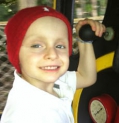
Childhood Cancer Awareness Month may be over, but the fight for cures continues every day.
By: Trish Adkins
Alex’s Lemonade Stand Foundation (ALSF) has declared a war on childhood cancer.
Every day of every month of every year, the equivalent of a classroom of children is diagnosed with cancer in the United States—all facing the fight of their lives.
ALSF has worked to find cures—and has already made incredible strides in improving standards of care, increasing the number of childhood cancer clinical trials, helping families access cutting-edge treatments and funding breakthroughs like CAR T cell immunotherapy. Until there are cures for all children, more work must be done.
Here are 10 facts you need to know about the war on childhood cancer:
1. Children are dying.
Childhood cancer is the leading cause of death by disease for children in the United States. One in five children diagnosed with cancer will die within five years. And every year, an estimated 80,000 children die from childhood cancer around the world.
2. The deadliest of all childhood cancers are brain tumors.
Brain tumors bumped leukemia out of the top spot in 2016. This isn’t because brain tumors are harder to treat, but because research has made enormous progress in treating several types of pediatric leukemia.
3. Childhood cancer is biologically different than adult cancers.
Even though they share the same name, childhood and adult cancers do not necessarily share the same treatment protocol.
4. Traveling for treatment can leave families with impossible choices.
The average cost of one hospital stay for a child with cancer is $40,000—five-times more than the cost of hospitalization for other pediatric health issues. Add another cost of traveling for treatment and families can be left choosing between putting gas in their tank and food on their table. In 2017, the ALSF Travel for Care program helped over 500 families access treatment by funding over 300 flights, 1,000 nights of lodging and 820,000 miles in gas cards.
5. Just a small portion of the federal budget for cancer research is allocated towards children.
Imagine being told you can only eat a portion of your meal. Or you can only have some of your paycheck each week. For cures to become a reality, private research funding, from organizations such as ALSF, is required.
6. The number of cures that researchers are searching for is infinite.
Childhood cancer is not just one disease or even a dozen diseases—there are hundreds of subtypes. Researchers are searching for genetic targets within tumors and then developing and matching drugs to attack those targets, making cures a reality.
7. Big data could hold one of the keys to cures.
As researchers continue to discover targeted therapies, they can turn to data for assistance. The Childhood Cancer Data Lab, funded by ALSF, provides researchers with faster, easier access to the wealth of childhood cancer data available.
8. It’s not just cures we need. We also need safer treatments.
Seventy-five percent of childhood cancer survivors are left with serious side effects for the remainder of their lives. Late effects of childhood cancer treatment affect organ and tissue function, growth and development, learning and memory and psychological adjustment. Treatment can also leave survivors at a higher risk of secondary cancers.
9. Accelerating the rate of clinical trials is key to accelerating cures.
Clinical trials provide two important functions: providing scientists with data and offering hope to children battling relapsed cancer. Clinical trials are expensive and time-consuming—but through the ALSF Infrastructure and Center of Excellence grant programs, institutions can access funds that support and speed up the establishment of clinical trials.
10. Innovative collaboration among researchers will lead to cures.
The childhood cancer research community is working together to find cures. Through the ALSF Crazy 8 Initiative—a groundbreaking effort to build a roadmap to cures—researchers are working in a coordinated effort to ensure childhood cancer is just a memory.
Learn more about how ALSF is funding breakthroughs and finding cures for childhood cancer and get more childhood cancer facts here.

